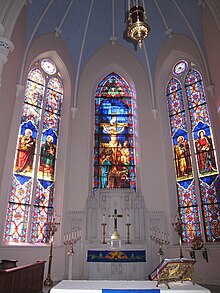
Franz Mayer of Munich is a German stained glass design and manufacturing company, based in Munich, Germany and major exponent of the Munich style of stained glass, that has been active throughout most of the world for over 170 years. The firm was very popular during the late nineteenth and early twentieth century, and was the principal provider of stained glass to the large Roman Catholic churches that were constructed throughout the world during that period. Franz Mayer of Munich were stained glass artists to the Holy See and consequently were popular with Roman Catholic clients. The family business is nowadays managed in the fifth generation and works in conjunction with renowned artists around the world.

The St. Luke and St. Paul Episcopal Church, located on Coming Street in Charleston, is the cathedral of the Anglican Diocese of South Carolina. It was originally known as St. Paul's Radcliffeboro.
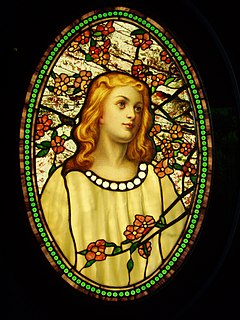
Tiffany glass refers to the many and varied types of glass developed and produced from 1878 to 1933 at the Tiffany Studios in New York, by Louis Comfort Tiffany and a team of other designers, including Clara Driscoll, Agnes F. Northrop, and Frederick Wilson.

St. Ann & the Holy Trinity Church is a historic Episcopal church located at the corner of Montague and Clinton streets in the Brooklyn Heights neighborhood of Brooklyn, New York City.

Calvary Episcopal Church is a parish of the Episcopal Diocese of Pittsburgh, Pennsylvania. The parish was founded in 1855.

Christ Church (Episcopal) is an Episcopal church in Greenville, South Carolina, United States. which was consecrated in 1854. The church and its courtyard are listed on the National Register of Historic Places as Christ Church (Episcopal) and Churchyard. It is the oldest organized religious body and the oldest church building remaining in Greenville.
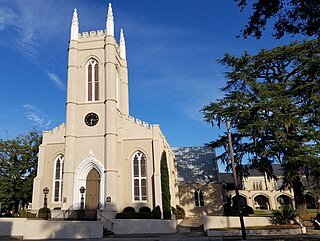
St. James Episcopal Church is a historic Episcopal church in the historic district of Wilmington, North Carolina. The church is part of the Episcopal Diocese of East Carolina and is the oldest church in the city of Wilmington. It is a contributing building in the Wilmington Historic District.
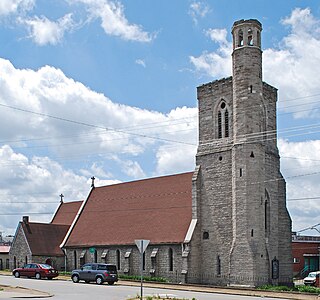
Holy Trinity Church is a historic Episcopal church at 615 6th Avenue South in Nashville, Tennessee, currently a parish of the Episcopal Diocese of Tennessee. The congregation was formed in 1849 as a mission of the nearby Christ Church Episcopal, attained parish status in 1851, and grew to around fifty members per service by the beginning of the American Civil War. During the war, the church was occupied by Federal troops and was badly damaged. After repairs, services continued and a new mission was opened on Wharf Avenue, which catered to the African American population of Nashville and soon overtook Holy Trinity in membership. After Holy Trinity lost parish status in 1895, the two missions merged and continued to serve the African American community of Nashville. Its congregation was largely made up of faculty and students from nearby Fisk University and other educational institutions. The mission reattained parish status in 1962, and the current rector is Bill Dennler.
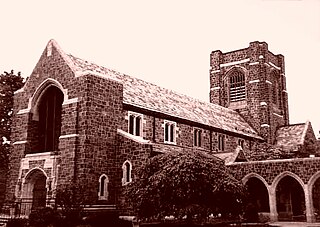
St. John's is an Episcopal Church located at 679 Farmington Avenue in West Hartford, Connecticut near the Hartford, Connecticut, city line. The parish was founded in 1841 as St. John's Episcopal Church in Hartford. The church's present building, designed by famed architect Bertram Grosvenor Goodhue, opened in 1909. It is noted for its reredos designed by Mr. Goodhue and executed by prominent sculptor Lee Lawrie; its organ, Opus 2761 by Austin Organs, Inc., with 64 ranks and 3721 pipes; and its thirty-six stained glass windows by designers/manufacturers such as the Harry Eldredge Goodhue Company of Cambridge, Massachusetts, Wilbur H. Burnham Studios of Boston, Massachusetts, and London, England's James Powell and Sons.

The German Evangelical Lutheran Church of Charleston, South Carolina, was incorporated on December 3, 1840. Through usage and custom the Church is now known as St. Matthew's German Evangelical Lutheran Church or St. Matthew's Lutheran Church and is a member of the South Carolina Synod of the Evangelical Lutheran Church in America.

St. John's Church, or St. John's Episcopal Church, founded in 1786, is an historic Episcopal church located at 101 South Prospect Street in the South Prospect Street Historic District of Hagerstown, Maryland. It is the seat of Saint John's Parish, Diocese of Maryland, which covers most of Washington County, Maryland.

The Church of Saint Luke and The Epiphany is an Episcopal congregation located at 330 South 13th Street between Spruce and Pine Streets in the Center City neighborhood of Philadelphia, Pennsylvania. It is part of the Diocese of Pennsylvania. The church was formed in 1898 as a result of the merger of St. Luke's Church (1839) and The Church of The Epiphany (1834), which consolidated at St. Luke's location.

Christ Cathedral is the cathedral church for the Episcopal Diocese of Western Kansas. It is located in Salina, Kansas, United States, and has been listed on the National Register of Historic Places since 2010.

Trinity Church on the Green or Trinity on the Green is a historic, culturally and community-active parish of the Episcopal Diocese of Connecticut in New Haven, Connecticut of the Episcopal Church. It is one of three historic churches on the New Haven Green.

The Trinity Episcopal Church, Staunton VA. is a Gothic Revival style building in Staunton, Virginia. It is an active Episcopal church in the Diocese of Southwestern Virginia. It was listed on the National Register of Historic Places (NRHP) in 1972. It is located in the Newtown Historic District.
St. Luke's Episcopal Church is located at 615 Vermillion Street in historic downtown Hastings, Minnesota, United States.
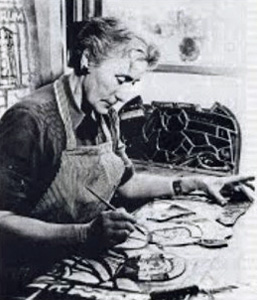
Katharine Lamb Tait was an American stained glass and mosaics designer, painter, muralist, and illustrator. She was the head designer at J&R Lamb Studios for more than four decades, and created notable commissions for the Tuskegee Institute Chapel and for chapels at the United States Marine Corps’ Camp Lejeune, among others.

Nicola D'Ascenzo was an Italian-born American stained glass designer, painter and instructor. He is best known for creating stained glass windows for the Washington Memorial Chapel in Valley Forge, Pennsylvania; the Nipper Building in Camden, New Jersey; the Loyola Alumni Chapel of Our Lady at Loyola University Maryland; the Folger Shakespeare Library and Washington National Cathedral, both in Washington, D.C.
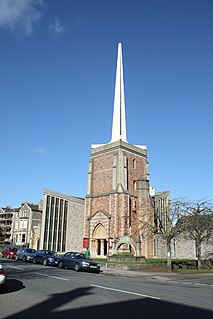
The Church of All Saints is a Church of England parish church in Clifton, Bristol. The church is a grade II listed building. It is located in the Parish of All Saints with St. John Clifton in the Diocese of Bristol.
